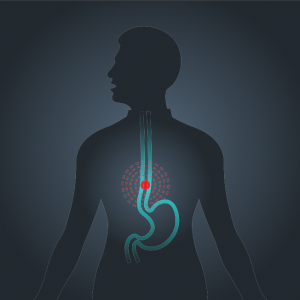New Test Developed for Pre-Cancerous Barrett’s Esophagus

A new test for Barrett’s esophagus, a precancerous forerunner of the much deadlier esophageal adenocarcinoma, is in clinical trials and may replace, or at least strongly augment, the standing procedure of endoscopy. Investigators at Case Western Reserve University School of Medicine and University Hospitals Cleveland Medical Center have developed a simple, swallowable test for early detection of Barrett’s esophagus (BE) that offers promise for preventing deaths from esophageal adenocarcinoma.
Esophageal adenocarcinoma, or EAC, is a highly lethal cancer with more than 80 percent mortality at five years. Early detection is key, and EAC can easily be prevented when still in the BE stage and early foci of near cancerous changes (dysplasias) are ablated. In a significant step forward, the Case Western team has developed an easy, five minute outpatient test that is more than 90 percent sensitive for detecting individuals with BE. Patients simply swallow a vitamin pill-sized balloon that swabs the esophagus, and that, after retrieval through the mouth (the “pill” is attached to a thin, silicone catheter), is tested for DNA abnormalities that the investigators discovered are diagnostic of BE. Traditional endoscopy is an expensive and invasive test that requires sedation and is thus often unsuitable as a method for wide BE screening.
“Our goal is early detection,” said Dr. Amitabh Chak, M.D., one of the developers of the pill and head of the Barrett’s Esophagus Translational Research Network BETRNet program. He points out that BE is often overlooked by patient and doctor alike because other, more common (and even more likely) conditions have the same symptoms.
“Symptoms, such as heartburn, can also be commonly seen in individuals who have acid reflux disease without BE,” he explains. “These symptoms can easily be treated by over the counter medications so people often don’t get tested for BE, particularly by an invasive test such as endoscopy. As a result, when individuals develop EAC, 95 percent of the time the presence of the prior Barrett’s esophagus was undetected and unknown. We wanted an easier, less costly test that could provide a practical way for screening and early detection of individuals with BE, who can then be followed closely to prevent development of EAC.”
In the clinical trial, patients tolerated the balloon test well, with 82 percent reporting little to no anxiety, pain, or choking, 93 percent stating they would repeat the procedure again, and 95 percent stating they would recommend the test to others. After delivery to the stomach, the small balloon was inflated by injecting air through the catheter. The inflated balloon was maneuvered to swab the lower esophagus near the stomach, the region where BE begins, and obtain a sample of the lining cells. Surface texturing on the balloon increased the effectiveness of the sampling. The balloon was then deflated through the catheter and inverted back into the capsule, thus protecting the esophagus sample from dilution or contamination. After retrieval of the capsule through the mouth, DNA was extracted from the balloon surface for testing.
The development of the balloon follows on the heels research done by the same team concerning for what DNA to test. It was previously found that two genetic biomarkers, VIM DNA methylation and CCNA1 DNA methylation, are common in BE.
“Having two accurate biomarkers increases confidence in our ability to correctly diagnose Barrett’s esophagus,” said Dr. Moinova, study first author and instructor at Case Western Reserve School of Medicine. “Taken together, our findings show that non-endoscopic balloon sampling paired with molecular tests for the methylated VIM and CCNA1 biomarkers is effective in addressing the need for simple, non-invasive, safe, and accurate Barrett’s esophagus screening.”
The research can found in the January 2018, issue of Science Translational Medicine.
References:
- Moinova, Helen et al. Identifying DNA methylation biomarkers for non-endoscopic detection of Barrett’s esophagus. (January, 2018). Science Translational Medicine. DOI: 10.1126/scitranslmed.aao5848













